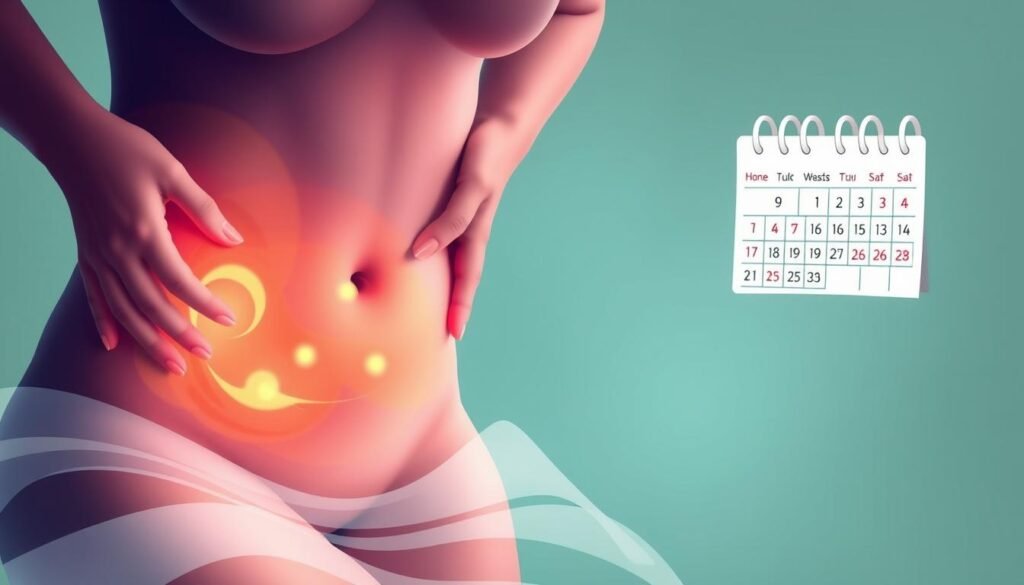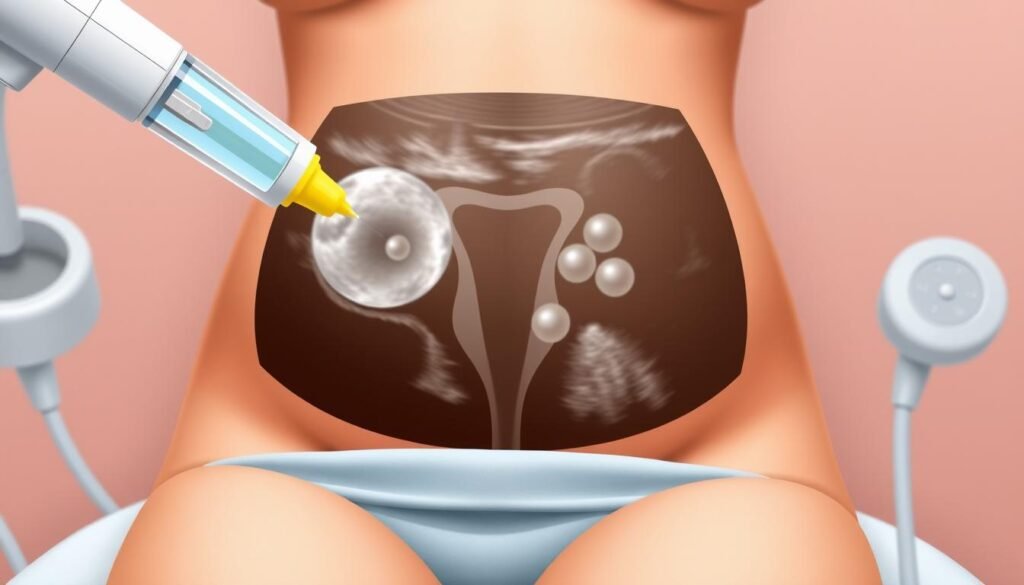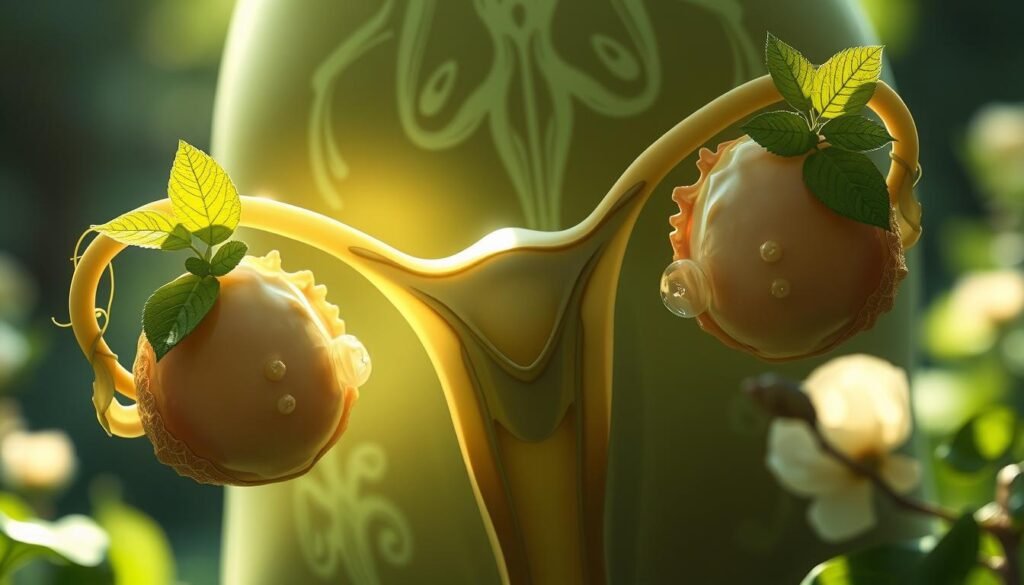Did you know about 10 out of 100 women get ovarian cysts at some point? Most of these cysts are not harmful and might not cause any symptoms. However, it’s important to know how they affect your menstrual health. Follicular cysts are the most common type of ovarian cyst. They form during a woman’s menstrual cycle. These cysts can change ovulation and hormone levels. Understanding these cysts helps women learn about their reproductive health and potential fertility issues.
Key Takeaways
- Around 10% of women may develop ovarian cysts at some point in their lives.
- Most ovarian cysts are benign and often resolve on their own.
- Follicular cysts primarily occur during a woman’s menstrual cycle.
- Understanding cysts can help in managing menstrual health and fertility.
- Common symptoms may include pain and changes in menstrual patterns.
- Birth control can help prevent the formation of functional cysts.
What Are Follicular Cysts?
Follicular cysts, also known as functional cysts, are fluid-filled sacs in the ovaries. They come from follicles, which should release eggs during ovulation. Sometimes, a follicle doesn’t open to release its egg. This causes fluid to build up and form a cyst.
These cysts mostly affect women who are of reproductive age. They are quite common. Prepubescent girls hardly ever get them. For postmenopausal women, cysts are rare and should be checked carefully.
Follicular cysts usually don’t pose big health risks. Most don’t hurt and go away by themselves in a few menstrual cycles. Some women may not know they have them, but others might feel abdominal pain, bloating, or nausea. Changes in menstrual patterns can also occur.
Factors that might increase the chance of getting these cysts include having ovarian cysts in the past, irregular menstrual cycles, starting menstruation early, hormonal imbalances, and high stress levels.
Knowing the difference between functional cysts and other kinds is key for ovarian health. Follicular cysts are mostly harmless and not likely to be cancerous. But, complex cysts found in women after menopause should be looked into more because of a higher cancer risk.
| Characteristics | Follicular Cysts | Other Ovarian Cysts |
|---|---|---|
| Typical Age of Occurrence | Women of reproductive age | Varies (can occur at any age) |
| Symptoms | Generally asymptomatic; may include abdominal pain, nausea, breast tenderness | May vary depending on type (can include pain, pressure) |
| Management | Often resolve on their own; monitoring for symptoms | May require additional treatment or evaluation |
| Risk Factors | Hormonal imbalances, stress, fertility drugs | Varies widely |
Understanding Ovarian Cysts
Ovarian cysts are fluid-filled sacs on or within the ovaries. They come in several types but mainly as functional or non-functional. Functional ones, like follicular and corpus luteum cysts, tie to our hormonal changes during the menstrual cycle.
Most ovarian cysts aren’t cancerous and tend to go away on their own, often unnoticed. Studies show many women will face ovarian cysts at some point. Though many are harmless and vanish by themselves, some may need medical treatment due to complications.
In premenopausal folks, ovulation, dermoid cysts, and PCOS are common causes. For those postmenopausal, cysts may form due to fluid collection or benign growths. The risk of cancer is slightly more for them.
Doctors use pelvic exams and imaging like ultrasounds or CT scans to diagnose them. Sometimes, blood tests such as CA 125 are done to check for cancer risks.
The treatment depends on the cyst’s size, symptoms, and what the doctor finds. Big or suspicious cysts might need surgery. Smaller, symptom-free cysts usually just need regular check-ups.
It helps to know about ovarian cysts, their symptoms, and types. This knowledge can help take care of your reproductive health. To learn more about hormonal issues, visit this link.
The Effect of Follicular Cysts on Ovulation and Menstrual Cycles
Follicular cysts are key in how they impact ovulation and menstrual cycles. They usually form when the lead follicle doesn’t release its egg. This turns into a fluid-filled structure. It can happen from day 14 to 21, but this might vary from person to person.
How Follicular Cysts Develop During Menstrual Cycles
In a normal menstrual cycle, ovaries prepare an egg for ovulation through follicles. A follicular cyst indicates that the main follicle kept the fluid instead of releasing an egg. This can upset the body’s hormone balance. It may cause irregular periods and change the menstrual cycle’s flow.
Hormonal Changes Associated with Follicular Cysts
A follicular cyst can throw off your hormone levels. The cyst makes estrogen and progesterone. These hormones thicken the menstrual lining leading to heavier or less regular periods. Most of these cysts go away on their own in a few months. However, they can affect ovulation and menstrual cycles for a bit. If symptoms last, seeing a doctor might be necessary. Learning about ovarian cysts is vital for reproductive health, as mentioned in this important source.
Symptoms of Follicular Cysts
Follicular cysts show different symptoms. Many women may have little to no symptoms. But, some can feel mild to severe discomfort.
Pain and Discomfort
Many women feel pelvic pain with follicular cysts. This pain can be dull or sharp, especially during sex or exercise. Sometimes, a sudden sharp pain may mean a cyst has burst or there’s another major issue. If pain lasts or is bad, it’s important to see a doctor.
Changes in Menstrual Patterns
Follicular cysts might change your menstrual cycle. Not all women with cysts will see these changes. But, some may get heavier periods, more spotting, or late periods. These changes can point to hormone shifts caused by the cyst. It’s important to keep track of your cycle changes, especially if they come with other symptoms. Visit WebMD for more info.

| Symptom | Description |
|---|---|
| Pelvic Pain | Can range from mild discomfort to sharp pain, especially during activities. |
| Bloating | Abdominal swelling that may accompany pain or discomfort. |
| Menstrual Irregularities | Heavier periods, spotting, or delayed cycles due to hormonal changes. |
| Nausea | May occur alongside discomfort or pelvic pain. |
Understanding these symptoms helps women get medical help when needed. Early action on any discomfort or menstrual changes aids in managing ovarian cysts well.
Causes of Follicular Cysts
Follicular cysts start from hormonal changes in the menstrual cycle. If a follicle doesn’t rupture to release an egg, it grows into a cyst. This shows how hormonal imbalance often plays a role, possibly causing reproductive problems.
Risk factors for follicular cysts include having irregular periods and being overweight. Both of these can alter hormone levels, leading to cysts. Also, fertility drugs that stimulate the ovaries can cause multiple cysts to form.
Stress and lifestyle factors may worsen hormonal fluctuations, raising the risk of developing cysts. By understanding what causes these cysts, we can take steps to improve reproductive health. Avoiding known risk factors and dealing with hormonal imbalances might reduce cyst formation.
Diagnosis of Follicular Cysts
Diagnosing follicular cysts involves a few key steps. Doctors start with a physical exam and use ultrasound imaging. These methods help confirm whether cysts are present.
During a physical check, doctors look for signs like tenderness in the pelvic area. If they find anything unusual, they’ll investigate further. This is how they start to understand the issue.
Ultrasound and Physical Exams
Ultrasound is a safe way to look inside the body. It shows pictures of the ovaries’ cysts. Doctors can tell the size and type of cysts they see, checking if they’re harmless or need more watching.
The physical exam helps too. Doctors check for any signs that might suggest problems. Together, these methods give a clear picture of what’s going on.
Blood Tests for Hormonal Levels
Blood tests are important for looking at hormones. They measure hormones like LH, FSH, and estradiol. This helps understand the body’s hormone balance.
Sometimes, a CA-125 test is done to check for cancer risk. These tests reveal much about reproductive health. They show if there’s a hormone problem that needs care.

Treatment Options for Follicular Cysts
Treatment for follicular cysts depends on their size, symptoms, and how long they’ve been there. Most of these cysts might go away on their own. They often get smaller within two months. If they hurt, taking pain relievers can ease the discomfort.
When Is Surgery Necessary?
Surgery is considered when a cyst causes a lot of pain, doesn’t go away, or looks complex in an ultrasound. Laparoscopy is one way doctors can check and possibly remove these cysts. If cancer is a concern, or if removing the cysts is complicated, a more extensive surgery might be needed. This could involve taking out one or both ovaries.
Non-surgical Management Approaches
For many, managing cysts non-surgically means keeping an eye on them and managing pain. Hormones might be used to help control your menstrual cycle and prevent new cysts. Doctors often recommend birth control pills, but they won’t make existing cysts go away faster. If there are no symptoms, waiting and watching is usually a good plan.
Impact on Fertility and Pregnancy
Follicular cysts usually don’t affect most women’s ability to have children. Functional ovarian cysts, especially those smaller than 10 centimeters, often go away on their own. They don’t impact the chance to get pregnant. About 70-80% of these cysts disappear in 1–3 months.
In some situations, removing ovarian cysts surgically might be needed. This is true for cysts that don’t go away or cause symptoms. Yet, this surgery can sometimes cause ovarian health issues.
Complications such as ovarian torsion can occur during pregnancy, leading to increased risks for the mom and baby. These issues require careful handling and regular check-ups. Interestingly, about 69.9% of women can get pregnant after having an ovarian cystectomy for endometriosis. This shows that good medical care can lead to successful pregnancies.
Conditions like polycystic ovary syndrome (PCOS) and endometriosis can directly challenge fertility. PCOS affects around 20% of women, often causing ovulation problems. This can make getting pregnant harder. Also, removing cysts through surgery may increase infertility risks, especially if both ovaries are involved. Knowing this highlights the importance of consulting a fertility expert when dealing with ovarian cysts and fertility issues.
| Condition | Impact on Fertility |
|---|---|
| Functional Ovarian Cysts | Minimal; typically resolve on their own |
| PCOS | Can hinder ovulation, affecting fertility |
| Endometriosis | May lead to infertility in 30-50% of cases |
| Surgery for Cysts | Possible impact on ovarian health and fertility |
| Ovarian Torsion | Risk during pregnancy; requires urgent care |

A balanced diet, regular exercise, and avoiding harmful substances are key to good ovarian health. These practices support fertility and reproductive wellness. Getting advice from healthcare providers offers personalized strategies, helping women navigate fertility and pregnancy paths successfully.
Preventive Measures for Follicular Cysts
It might be hard to completely prevent follicular cysts, but some steps can really help. Taking action like staying at a healthy weight, reducing stress, and using contraception can lower your risks. These common steps are part of what doctors suggest for keeping ovaries healthy.
Seeing your gyno regularly is key for catching ovarian cysts early. These check-ups help deal with any cysts before they become a big issue. Catching them early makes managing and treating them much easier.
Here are some good strategies for people who might get cysts:
- Eat a diet full of fruits, vegetables, and whole grains
- Stay active to help keep your hormones in check
- Cut back on processed foods and sugars
- Try yoga or meditation to lower stress
- Think about birth control pills to possibly shrink cysts
Knowing the best ways to handle and lower the risks of ovarian cysts is crucial. For more tips, including home treatments to ease discomfort, look at this link.
| Preventive Measure | Description |
|---|---|
| Healthy Diet | Eating whole foods instead of processed ones helps balance hormones. |
| Regular Exercise | Being active helps with your weight and hormones. |
| Stress Management | Mindfulness or yoga reduces stress, affecting your hormonal health. |
| Routine Check-ups | Seeing a gynecologist often helps in spotting cysts early. |
| Birth Control Options | Talking to a doctor about hormonal treatments may prevent cysts. |
Conclusion
Understanding follicular cysts is key to women’s menstrual and ovarian health. These cysts are usually harmless and go away on their own. Still, they can affect menstrual cycles and hormones. Knowing the signs, how they’re found, and treatment choices lets women take charge of their health. This approach leads to better health outcomes and eases worries about fertility and well-being.
Research shows that ovarian cysts are common among women of childbearing age. However, having cysts doesn’t mean a woman can’t have children. Clinical pregnancy rates in assisted reproduction don’t differ much between women with and without cysts. Age and health play big roles in fertility, highlighting the need for personal medical advice.
In conclusion, knowing about follicular cysts helps women manage their reproductive health better. With this knowledge, they can seek early care and prevention. They can make smart choices about their health. This not only helps them face health issues with confidence but also promotes overall health and wellness.